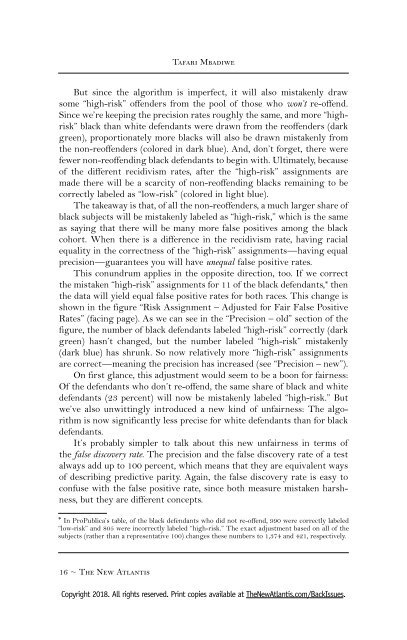The New Atlantis - Winter 2018 (Issue 54) uncompressed with cover
Create successful ePaper yourself
Turn your PDF publications into a flip-book with our unique Google optimized e-Paper software.
Tafari Mbadiwe<br />
But since the algorithm is imperfect, it will also mistakenly draw<br />
some “high-risk” offenders from the pool of those who won’t re-offend.<br />
Since we’re keeping the precision rates roughly the same, and more “highrisk”<br />
black than white defendants were drawn from the reoffenders (dark<br />
green), proportionately more blacks will also be drawn mistakenly from<br />
the non-reoffenders (colored in dark blue). And, don’t forget, there were<br />
fewer non-reoffending black defendants to begin <strong>with</strong>. Ultimately, because<br />
of the different recidivism rates, after the “high-risk” assignments are<br />
made there will be a scarcity of non-reoffending blacks remaining to be<br />
correctly labeled as “low-risk” (colored in light blue).<br />
<strong>The</strong> takeaway is that, of all the non-reoffenders, a much larger share of<br />
black subjects will be mistakenly labeled as “high-risk,” which is the same<br />
as saying that there will be many more false positives among the black<br />
cohort. When there is a difference in the recidivism rate, having racial<br />
equality in the correctness of the “high-risk” assignments — having equal<br />
precision — guarantees you will have unequal false positive rates.<br />
This conundrum applies in the opposite direction, too. If we correct<br />
the mistaken “high-risk” assignments for 11 of the black defendants, * then<br />
the data will yield equal false positive rates for both races. This change is<br />
shown in the figure “Risk Assignment – Adjusted for Fair False Positive<br />
Rates” (facing page). As we can see in the “Precision – old” section of the<br />
figure, the number of black defendants labeled “high-risk” correctly (dark<br />
green) hasn’t changed, but the number labeled “high-risk” mistakenly<br />
(dark blue) has shrunk. So now relatively more “high-risk” assignments<br />
are correct — meaning the precision has increased (see “Precision – new”).<br />
On first glance, this adjustment would seem to be a boon for fairness:<br />
Of the defendants who don’t re-offend, the same share of black and white<br />
defendants (23 percent) will now be mistakenly labeled “high-risk.” But<br />
we’ve also unwittingly introduced a new kind of unfairness: <strong>The</strong> algorithm<br />
is now significantly less precise for white defendants than for black<br />
defendants.<br />
It’s probably simpler to talk about this new unfairness in terms of<br />
the false dis<strong>cover</strong>y rate. <strong>The</strong> precision and the false dis<strong>cover</strong>y rate of a test<br />
always add up to 100 percent, which means that they are equivalent ways<br />
of describing predictive parity. Again, the false dis<strong>cover</strong>y rate is easy to<br />
confuse <strong>with</strong> the false positive rate, since both measure mistaken harshness,<br />
but they are different concepts.<br />
* In ProPublica’s table, of the black defendants who did not re-offend, 990 were correctly labeled<br />
“low-risk” and 805 were incorrectly labeled “high-risk.” <strong>The</strong> exact adjustment based on all of the<br />
subjects (rather than a representative 100) changes these numbers to 1,374 and 421, respectively.<br />
16 ~ <strong>The</strong> <strong>New</strong> <strong>Atlantis</strong><br />
Copyright <strong>2018</strong>. All rights reserved. Print copies available at <strong>The</strong><strong>New</strong><strong>Atlantis</strong>.com/Back<strong>Issue</strong>s.


